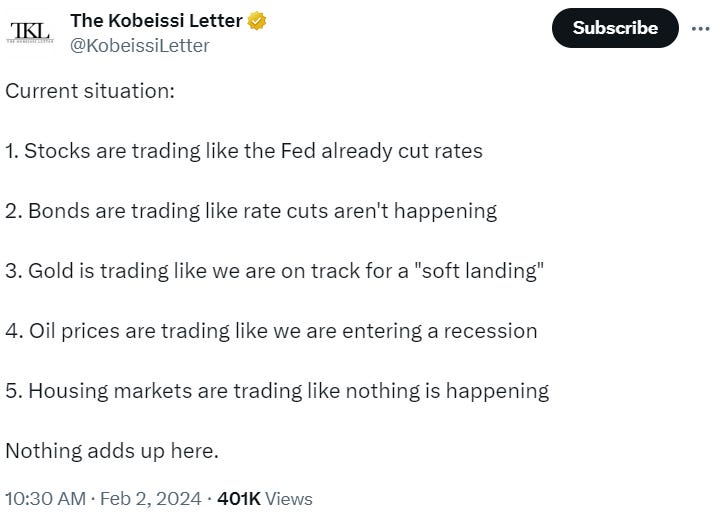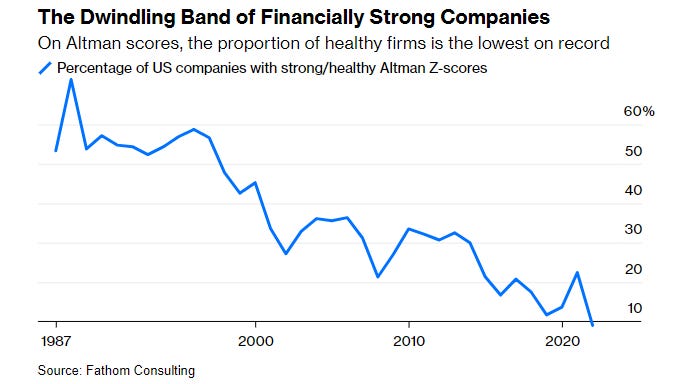Weekly Good Reads: 5-1-1
Higher for Longer (again), Commercial Real Estate, Crypto Valuation, Economic Exposure, Quality Stocks
Welcome to Weekly Good Reads 5-1-1 by Marianne O, a 25-year investment practitioner and the author of
on investing, economy, and wellness in an intuitive voice. All the Weeklies are here, and here is the index of charts and terms. You can easily subscribe to my newsletter by clicking below.Thank you so much 🙏.
Market and Data Comments
The below tweet sums up well the divergent opinions implied by the capital markets as to how our economy is doing. However, disagreement about where the economy is going will lead us to a healthier relationship with risk — investors are less likely to take undue risk or be unhedged.

This week, Fed Chairman Powell chopped off the probability of a March interest rate cut, citing they needed to gain “greater confidence that inflation is moving toward two per cent,” and more “good data” notably on inflation and wages (see “A Hawkish Hold” in Econ/Investments.)
His comments were reinforced by a blowout job report last Friday when the US added 353,000 jobs in January, with November and December jobs revised up by 126,000. The 3-month annualized 289,000 job gains are the strongest since March 2023 while the total 2023 job gains were 3.1 million.
Average hourly earnings increased 0.6% from December and 4.5% yoy thanks partly to reduced hours and a rise in part-time jobs. A 3 to 3.5% wage growth range is more consistent with the Fed’s 2% inflation target. Unemployment rate edged down to 3.66% from 3.74%. Wage pressures and demand are alive in the system.
Fed has indicated rate cuts will happen this year, likely starting in May as
described in his post three reasons why. To me, the most serious reason is the health of the commercial real estate market and the adverse impact on the health and refinancing of regional banks and small businesses. A recession is much more likely if the interest rate is kept too high for too long. See the chart above on the rapidly falling number of financially strong US companies (also see article 2 in Econ/Invest. below). One possible beneficiary - long-term US Treasuries.Both central banks in the UK and Europe signalled rate cuts this year but reiterated waiting for more evidence/trend of falling inflation.
While the US stock market and economy feel like joyful spring, evidence that China has not been able to revive its domestic demand is rampant: Apple’s fiscal first quarter sales in China dropped 13%, sluggish pork demand in China despite the incoming Lunar New Year (February 10), Chinese onshore stocks dropping for 3 consecutive years, and the latest core inflation at 0.6% yoy, in addition to the property woes.
This coming week, we will monitor Fed Chairman Powell's “60 Minutes” TV interview on Sunday, China’s January CPI and PPI on Wednesday and December German industrial production and China’s January aggregate financing on Thursday.
Economy and Investments (Links):
Jay Powell is Willing to Cut Interest Rates—But Not Yet (FT vs. Archive.com)
+Related: A Hawkish Hold (Diana Swonk, KPMG Economist)
Bank Stress Is Wake-Up Call Yields Are Going Higher: MacroScope (on Bloomberg Terminal or click this link)
Big Tech Earnings Were a Big Win. Here Are the 7 Top Takeaways (Barron’s via Archive.com)
Finance/Wealth (Link):
Valuation of Crypto Assets: A Guide for Investment Professionals (Long read, CFA Institute)
For bitcoin, we show the strengths and limitations of four models: the total addressable market approach, the stock-to-flow model, Metcalfe’s law, and the cost of production model. Each model is derived from an underlying characteristic of bitcoin and takes differing viewpoints by assessing the store-of-value or medium-of-exchange approach for bitcoin.
+ The Tragic Irony of Overconfidence in Investing - How to identify and overcome this common bias (Morningstar)
However measured, overconfidence is strongly linked with more frequent trading, which tends to result in lower returns overall.
The great irony is that overconfident investors set themselves up to underperform compared with the market and their peers because the more often you trade, the more likely you are to make costly mistakes.
Wellness/Idea (Link):
Tea Drinkers May Age Slower, Scientists Reveal (Newsweek)
The relationship suggested that consuming around three cups of tea, or 6 to 8 grams of tea leaves per day, may offer the most evident anti-aging benefits," the authors write.
Of course, this correlation does not necessarily imply causation, but there are a number of molecules inside tea that might be behind these potential anti-aging properties. Tea is rich in polyphenols and antioxidants, which are thought to play a role in reducing inflammation, mopping up toxic byproducts of cellular reactions and increasing cell turnover.
One Chart You Should Not Miss: Economic Exposures of the MSCI All-Country World Index Constituent Markets
For institutional fund managers, the MSCI stock market indices such as the MSCI World (developed markets) and the MSCI All-Country World (developed and emerging markets) are the key benchmarks for performance comparison.
MSCI has also created an economic exposure index to measure where revenues of the constituent of each country's stock market index come from—North America, Emerging Markets, Europe and Middle East, and the Pacific. Investors can see how integrated into the global regions each market is.
Interestingly, 7 European indices have at least 30% of their economic exposure to North America while China has less than 5% of its sales exposed to North America and Japan looks to have a more balanced economic exposure regionally.
One Term To Know: Quality Stocks
Factor-based investing is a way to construct a portfolio. Factors, represented by certain characteristics, can explain the long-term risks and returns of an asset. Factors can include growth, value, dividend, quality, momentum, and low volatility.
Quality factors have become popular, especially after the collapse of the 2001 Dot-com bubble and the Enron crisis, and it remains an important factor to consider in today’s investing environment.
What types of companies are considered “quality” stocks? They refer to more “defensive” companies with durable business models and sustainable competitive advantages. Quality stocks generally have low leverage, stable earnings and high profitability.
MSCI measures quality by 3 fundamental variables:
• Return on equity – how effectively a company uses capital to generate earnings growth
• Debt to equity – a measure of company leverage
• Earnings variability – how smooth/stable earnings growth has been
The outperformance of the quality factor against the market has been well-documented in the financial literature. In 2012, researcher Robert Novy-Marx found profitability and stability (quality) explained asset returns equally as well as the value factor.
From the table below, you can see the quality index traditionally is among the top 3 best-performing indices among the various factors.

Please do not hesitate to get in touch if you have any questions! If you like this weekly, please share it with your friends or subscribe to my newsletter.
👋 This year, I will share my interviews with female fund managers, investors, founders, technologists and more with the first one below. Subscribe to follow.
Thank you so much for reading and supporting my work 🙏.







Thanks so much @Stirling S Newberry for restacking - much appreciate it!